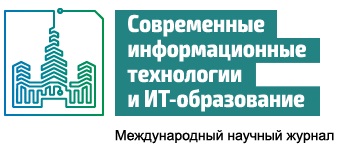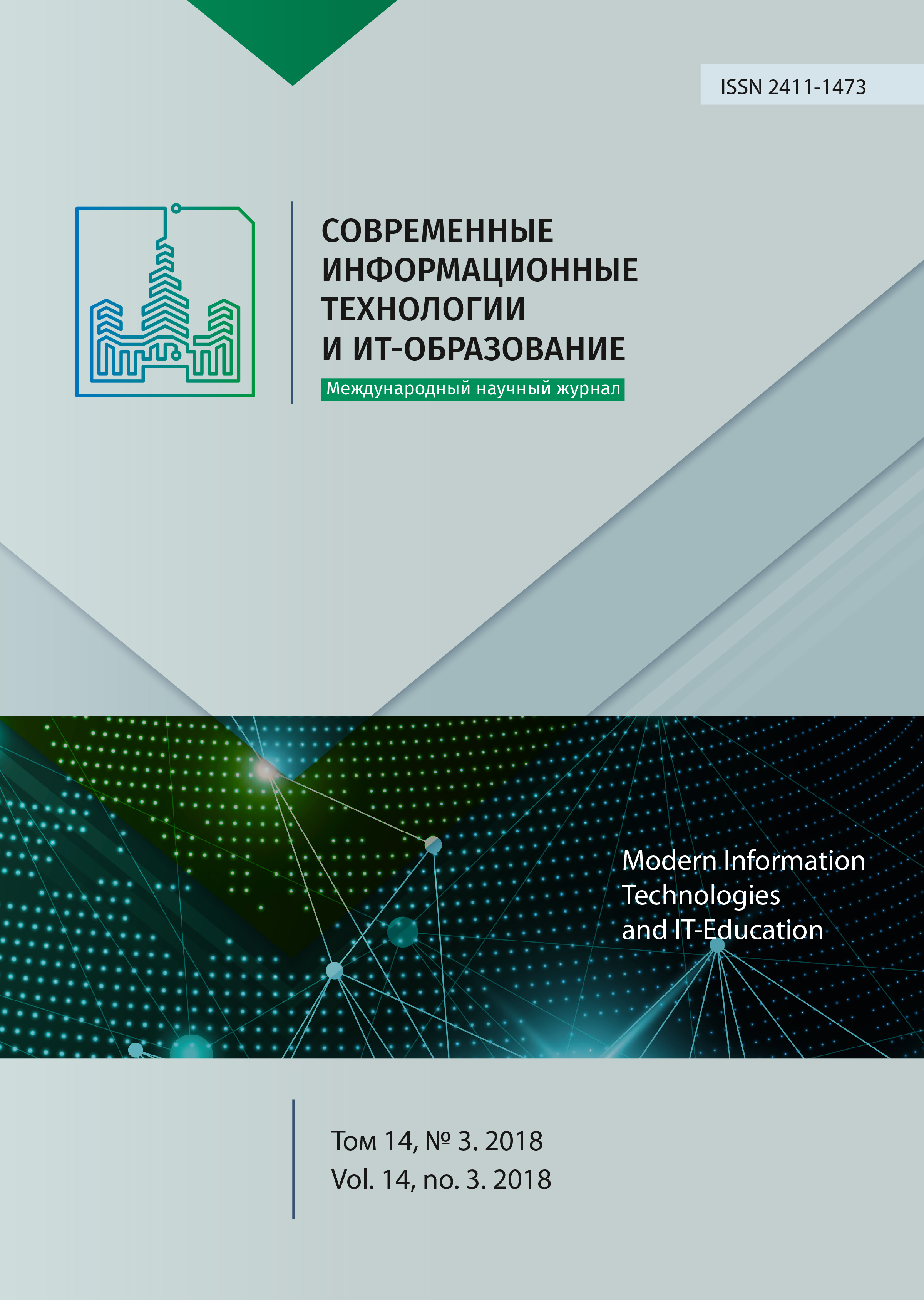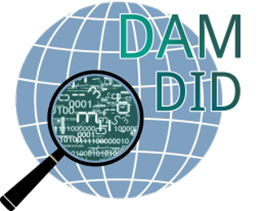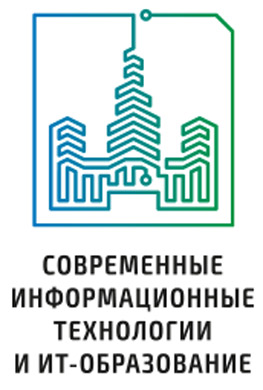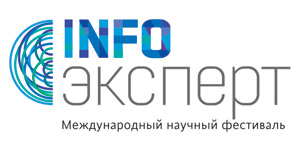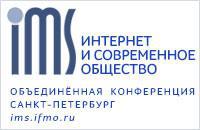METHODS OF CREATING DIGITAL TWINS BASED ON NEURAL NETWORK MODELING
Abstract
It is assumed that by 2021, about half of the companies will use digital counterparts of different levels. The simplest digital twin models may not use machine learning, but the models using machine learning algorithms will have the greatest advantage. In this article, we offer our approach to the construction of digital twins for real objects. We rely on our unified process of constructing approximate solutions of boundary value problems for equations of mathematical physics and accumulated experience in solving numerous specific problems of this type. In this paper, we present five approaches to the construction of digital twin models based on the evolutionary algorithms developed and tested by us. The peculiarity of our approach to evolutionary algorithms is the use of genetic procedures for constructing the structure of the model and nonlinear optimization algorithms for adjusting its parameters. Also, we propose our approach to the construction of multilayer models upon differential equations, which allows doing without the time-consuming procedure of neural networks training. We are confident that the proposed approaches can significantly simplify and unify the creation and adaptation (keeping up to date) of digital twins for real objects of various kinds – technical, biological, socio-economic, etc.
References
[2] Uhlemann T.H.-J., Schock C., Lehmann C., Freiberger S., Steinhilper R. The Digital Twin: Demonstrating the Potential of Real Time Data Acquisition in Production Systems. Procedia Manufacturing. 2017; 9:113-120. DOI: 10.1016/j.promfg.2017.04.043
[3] Boschert S., Rosen R. Digital Twin – The Simulation Aspect. P. Hehenberger, D. Bradley (Eds.) Mechatronic Futures. Springer International Publishing, 2016. Pp. 59-74. DOI: 10.1007/978-3-319-32156-1_5
[4] Dong-Ki K. et al. A Study of Resource Management for Fault-Tolerant and Energy Efficient Cloud Datacenter. Y. Zhang, L. Peng, C-H. Youn (Eds.) Cloud Computing. 6th International Conference, CloudComp 2015, Daejeon, South Korea, October 28-29, 2015, Revised Selected Papers. Lecture Notes of the Institute for Computer Sciences, Social Informatics and Telecommunications Engineering. Vol. 167. Springer International Publishing, 2016. Pp. 22-29. DOI: 10.1007/978-3-319-38904-2_3
[5] Chawla V., Sogani P. Cloud Computing – The Future. A. Mantri, S. Nandi, G. Kumar, S. Kumar (Eds.) High Performance Architecture and Grid Computing. HPAGC 2011. Communications in Computer and Information Science, Vol. 169. Springer, Berlin, Heidelberg, 2011. Pp. 113-118. DOI: 10.1007/978-3-642-22577-2_15
[6] Strang G., Fix G.J. An Analysis of the Finite Element Method. Vol. 212. Prentice-Hall, Englewood Cliffs, NJ, 1973. 306 p.
[7] Hughes T.J. The Finite Element Method: Linear Static and Dynamic Finite Element Analysis. Courier Corporation, North Chelmsford, 2012. 704 p.
[8] Dhatt G., Lefrançois E., Touzot G. Finite Element Method. London, Wiley-ISTE, 2012. 624 p.
[9] Bathe K.J. Finite Element Method. Wiley Encyclopedia of Computer Science and Engineering. London, Wiley Online Library, 2008. DOI: 10.1002/9780470050118.ecse159
[10] Nguyen V.P., Rabczuk T., Bordas S., Duflot M. Meshless methods: a review and computer implementation aspects. Mathematics and Computers in Simulation. 2008; 79(3):763-813. DOI: 10.1016/j.matcom.2008.01.003
[11] Nguyen V.P., Anitescu C., Bordas S.P., Rabczuk T. Isogeometric analysis: an overview and computer implementation aspect. Mathematics and Computers in Simulation. 2015; 117:89-116. DOI: 10.1016/j.matcom.2015.05.008
[12] Hughes T.J., Cottrell J.A., Bazilevs Y. Isogeometric analysis: CAD, finite elements, NURBS, exact geometry and mesh refinement. Computer Methods in Applied Mechanics and Engineering. 2005; 194(39-41):4135-4195. DOI: 10.1016/j.cma.2004.10.008
[13] Marussig B., Zechner J., Beer G., Fries T.P. Fast isogeometric boundary element method based on independent field approximation. Computer Methods in Applied Mechanics and Engineering. 2015; 284:458-488. DOI: 10.1016/j.cma.2014.09.035
[14] Atroshchenko E., Xu G., Tomar S., Bordas S. Weakening the tight coupling between geometry and simulation in isogeometric analysis: from sub-and super-geometric analysis to Geometry Independent Field approximaTion (GIFT). 2017. arXiv:1706.06371
[15] Saputra A., Talebi H., Tran D., Birk C., Song C. Automatic image-based stress analysis by the scaled boundary finite element method. International Journal for Numerical Methods in Engineering. 2017; 109(5):697-738. DOI: 10.1002/nme.5304
[16] Ooi E., Song C., Natarajan S. A scaled boundary finite element formulation with bubble functions for elasto-static analyses of functionally graded materials. Computational Mechanics. 2017; 60(6):943–967. DOI: 10.1007/s00466-017-1443-y
[17] Natarajan S., Ooi E.T., Saputra A., Song C. A scaled boundary finite element formulation over arbitrary faceted star convex polyhedral. Engineering Analysis with Boundary Elements. 2017; 80:218-229. DOI: 10.1016/j.enganabound.2017.03.007
[18] Simpson R., Trevelyan J. A partition of unity enriched dual boundary element method for accurate computations in fracture mechanics. Computer Methods in Applied Mechanics and Engineering. 2011; 200(1-4):1-10. DOI: 10.1016/j.cma.2010.06.015
[19] Peng X., Atroshchenko E., Kerfriden P., Bordas S. Isogeometric boundary element methods for three dimensional static fracture and fatigue crack growth. Computer Methods in Applied Mechanics and Engineering. 2017; 316:151-185. DOI: 10.1016/j.cma.2016.05.038
[20] Scott M.A., Simpson R.N., Evans J.A., Lipton S., Bordas S.P., Hughes T.J., Sederberg T.W. Isogeometric boundary element analysis using unstructured T-splines. Computer Methods in Applied Mechanics and Engineering. 2013; 254:197-221. DOI: 10.1016/j.cma.2012.11.001
[21] Oden J.T., Lima E.A., Almeida R.C., Feng Y., Rylander M.N., Fuentes D., Faghihi D., Rahman M.M., DeWitt M., Gadde M., Cliff Z.J. Toward predictive multiscale modeling of vascular tumor growth. Archives of Computational Methods in Engineering. 2016; 23(4):735-779. DOI: 10.1007/s11831-015-9156-x
[22] Fuentes D., Oden J., Diller K., Hazle J., Elliott A., Shetty A., Stafford R. Computational modeling and real-time control of patient-specific laser treatment of cancer. Annals of Biomedical Engineering. 2009; 37(4):763-782. DOI: 10.1007/s10439-008-9631-8
[23] Lê M., Delingett, H., Kalpathy-Cramer J., Gerstner E.R., Batchelor T., Unkelbach J., Ayache N. Bayesian Personalization of Brain Tumor Growth Model. A.F. Frangi, J. Hornegger, N. Navab, W.M. Wells (Eds.) MICCAI - Medical Image Computing and Computer Assisted Intervention. 2015, Oct 2015, Munich, Germany. Lecture Notes in Computer Science - LNCS. Vol. 9350. Springer, New York, 2015. Pp. 424–432. DOI: 10.1007/978-3-319-24571-3_51
[24] Le Folgoc L., Delingette H., Criminisi A., Ayache N. Sparse Bayesian registration. P. Golland, N. Hata, C. Barillot, J. Hornegger, R. Howe (Eds.) MICCAI - Medical Image Computing and Computer Assisted Intervention. Proceedings of the 7th International Conference, Boston, MA, USA, September 14-18, 2014. Part I. Lecture Notes in Computer Science - LNCS. Vol. 8673. Springer, Cham, 2014. Pp. 235-242. DOI: 10.1007/978-3-319-10404-1\_30
[25] Haykin S. Neural Networks: A Comprehensive Foundation. Prentice Hall, 1999. 823 p.
[26] Vasilyev A., Tarkhov D. Mathematical Models of Complex Systems on the Basis of Artificial Neural Networks. Nonlinear Phenomena in Complex Systems, 2014; 17(3):327-335.
[27] Tarkhov D.A., Vasilyev A.N. New neural network technique to the numerical solution of mathematical physics problems. I: Simple problems. Optical Memory and Neural Networks (Information Optics). 2005; 14(1):59-72.
[28] Tarkhov D.A., Vasilyev A.N. New neural network technique to the numerical solution of mathematical physics problems. II: Complicated and nonstandard problems. Optical Memory and Neural Networks (Information Optics). 2005; 14(2):97-122.
[29] Gorbachenko V.I., Lazovskaya T.V., Tarkhov D.A., Vasilyev A.N., Zhukov M.V. Neural Network Technique in Some Inverse Problems of Mathematical Physics. L. Cheng, Q. Liu, A. Ronzhin (Eds.) Advances in Neural Networks – ISNN 2016. ISNN 2016. Lecture Notes in Computer Science - LNCS. Vol. 9719. Springer, Cham, 2016. Pp. 310-316. DOI: 10.1007/978-3-319-40663-3_36
[30] Shemyakina T.A., Tarkhov D.A., Vasilyev A.N. Neural Network Technique for Processes Modeling in Porous Catalyst and Chemical Reactor. L. Cheng, Q. Liu, A. Ronzhin (Eds.). Advances in Neural Networks – ISNN 2016. ISNN 2016. Lecture Notes in Computer Science - LNCS. Vol. 9719. Springer, Cham, 2016. Pp. 547-554. DOI: 10.1007/978-3-319-40663-3_63
[31] Kainov N.U., Tarkhov D.A., Shemyakina T.A. Application of Neural Network Modeling to Identification and Prediction Problems in Ecology Data Analysis for Metallurgy and Welding Industry. Nonlinear Phenomena in Complex Systems. 2014; 17(1):57–63.
[32] Kaverzneva T., Lazovskaya T., Tarkhov D., Vasilyev A. Neural network modeling of air pollution in tunnels according to indirect measurements. Journal of Physics: Conference Series. 2016; 772(1):012035. DOI: 10.1088/1742-6596/772/1/012035
[33] Lazovskaya T.N., Tarkhov D.A., Vasilyev A.N. Parametric Neural Network Modeling in Engineering. Recent Patents on Engineering. 2017; 11(1):10-15. DOI: 10.2174/1872212111666161207155157
[34] Budkina E.M., Kuznetsov E.B., Lazovskaya T.V., Tarkhov D.A., Shemyakina T.A., Vasilyev A.N. Neural network approach to intricate problems solving for ordinary differential equation. Optical Memory and Neural Networks. 2017; 26(2):96-109. DOI: 10.3103/S1060992X17020011
[35] Antonov V., Tarkhov D., Vasilyev A. Unified approach to constructing the neural network models of real objects. Part 1. Mathematical Methods in the Applied Sciences. 2018; 41(18):9244-9251. DOI: 10.1002/mma.5205
[36] Ivakhnenko A.G., Yurachkovsky Yu.P. Simulation of complex systems from experimental data [Modelirovanie slozhnyh sistem po ehksperimental'nym dannym]. M.: Radio and Communication, 1987. 120 p. (In Russian).
[37] Rastrigin L.A., Erenshtein R.H. Method of collective recognition [Metod kollektivnogo raspoznavanija]. M.: Energoizdat, 1981. 80 p. (In Russian)
[38] Lazovskaya T., Tarkhov D. Multilayer neural network models, based on grid methods. IOP Conference Series: Materials Science and Engineering. 2016; 158(1):012061. DOI: 10.1088/1757-899X/158/1/012061
[39] Lazovskaya T., Tarkhov D., Vasilyev А. Multi-Layer Solution of Heat Equation. B. Kryzhanovsky, W. Dunin-Barkowski, V. Redko (Eds.) Advances in Neural Computation, Machine Learning, and Cognitive Research. Studies in Computational Intelligence. Vol. 736. Springer International Publishing, 2018. Pp. 17–22. DOI: 10.1007/978-3-319-66604-4_3
[40] Vasilyev A.N., Tarkhov D.A., Tereshin V.A., Berminova M.S., Galyautdinova A.R. Semi-empirical Neural Network Model of Real Thread Sagging. B. Kryzhanovsky, W. Dunin-Barkowski, V. Redko (Eds.) Advances in Neural Computation, Machine Learning, and Cognitive Research. Studies in Computational Intelligence. Vol. 736. Springer International Publishing, 2018. Pp. 138–146. DOI: 10.1007/978-3-319-66604-4_21
[41] Zulkarnay I.U., Kaverzneva T.T., Tarkhov D.A., Tereshin V.A., Vinokhodov T.V., Kapitsin D.R. A Two-layer Semi-Empirical Model of Nonlinear Bending of the Cantilevered Beam. IOP Conference Series: Journal of Physics: Conference Series. 2018; 1044(conf. 1):012005. DOI: 10.1088/1742-6596/1044/1/012005
[42] Bortkovskaya M.R., Vasilyev P.I., Zulkarnay I.U., Semenova D.A., Tarkhov D.A., Udalov P.P., Shishkina I.A. Modeling of the membrane bending with multilayer semi-empirical models based on experimental data. V. Sukhomlin, E. Zubareva, M. Shneps-Shneppe (Eds.) Proceedings of the 2nd International scientific conference "Convergent cognitive information technologies" (Convergent’2017). Moscow, Russia: November 24–26, 2017. CEUR Workshop Proceedings. Vol. 2064. Pp. 150-156. Available at: http://ceur-ws.org/Vol-2064/paper18.pdf (accessed 05.06.2018).
[43] Vasilyev A., Tarkhov D., Shemyakina T. Approximate analytical solutions of ordinary differential equations. V. Sukhomlin, E. Zubareva, M. Shneps-Shneppe (Eds.) Proceedings of the XI International Scientific-Practical Conference “Modern Information Technologies and IT-Education” (SITITO 2016). Moscow, Russia, November 25-26. 2016. CEUR Workshop Proceedings. Vol. 1761. Pр. 393-400. Available at: http://ceur-ws.org/Vol-1761/paper50.pdf (accessed 05.06.2018). (In Russian)
[44] Tarkhov D., Shershneva E. Approximate analytical solutions of Mathieu's equations based on classical numerical methods. V. Sukhomlin, E. Zubareva, M. Shneps-Shneppe (Eds.) Proceedings of the XI International Scientific-Practical Conference “Modern Information Technologies and IT-Education” (SITITO 2016). Moscow, Russia, November 25-26. 2016. CEUR Workshop Proceedings. Vol. 1761. Pр. 356-362. Available at: http://ceur-ws.org/Vol-1761/paper46.pdf (accessed 05.06.2018). (In Russian)

This work is licensed under a Creative Commons Attribution 4.0 International License.
Publication policy of the journal is based on traditional ethical principles of the Russian scientific periodicals and is built in terms of ethical norms of editors and publishers work stated in Code of Conduct and Best Practice Guidelines for Journal Editors and Code of Conduct for Journal Publishers, developed by the Committee on Publication Ethics (COPE). In the course of publishing editorial board of the journal is led by international rules for copyright protection, statutory regulations of the Russian Federation as well as international standards of publishing.
Authors publishing articles in this journal agree to the following: They retain copyright and grant the journal right of first publication of the work, which is automatically licensed under the Creative Commons Attribution License (CC BY license). Users can use, reuse and build upon the material published in this journal provided that such uses are fully attributed.
